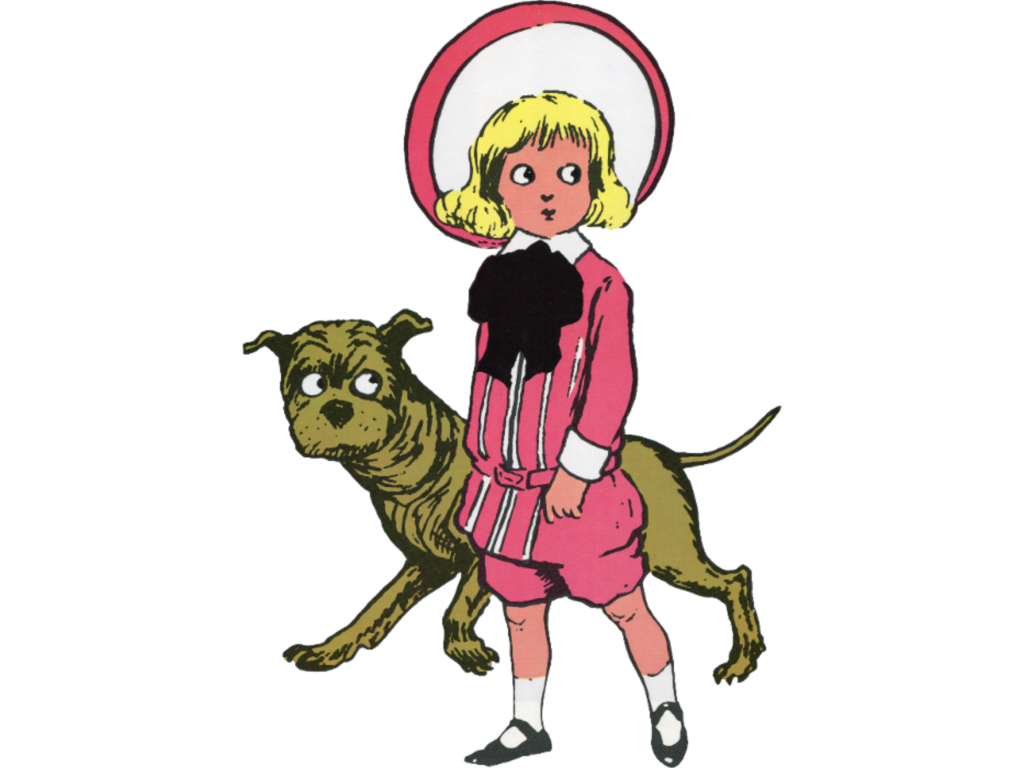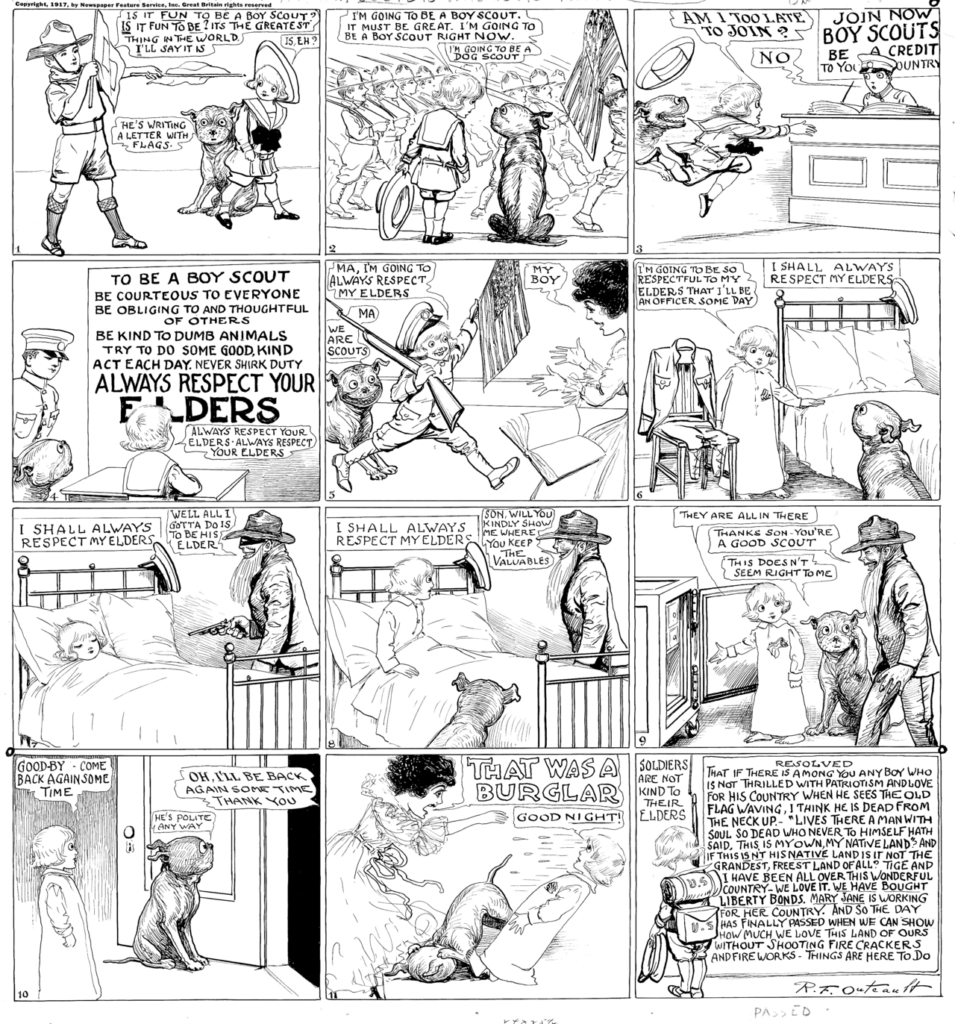Buster Brown, a beloved American comic strip character, emerged on the scene in 1902 through the creative genius of Richard F. Outcault. This naughty young boy, along with his faithful canine companion Tige, quickly captured the hearts of the American public in the early 20th century. Not only did Buster Brown become an iconic character in the world of comics, but his name also found its way into popular fashion, forever associated with a distinctive style for young boys known as the “Buster Brown suit.” In this article, we delve into the origins, history, and enduring legacy of Buster Brown.
Buster Brown
Created by: Richard F. Outcault
Debut: May 4, 1902
Genres: Humor
Status: Concluded
Publisher: New York Herald (1902–1906), Hearst Corporation (1906–c. 1921)
Notable Characters: Buster Brown, Mary Jane, Tige
The Origins of Buster Brown

The character of Buster Brown drew inspiration from real-life individuals, blending elements of Granville Hamilton Fisher and Roger Cushman Clark. Granville Hamilton Fisher, the son of Charles and Anna Fisher of Flushing, New York, served as the physical basis for Buster Brown’s appearance, including his signature pageboy haircut. Interestingly, Buster’s name was indirectly influenced by the child actor Buster Keaton, a popular figure in vaudeville at the time. Another boy, Roger Cushman Clark, from Deadwood, South Dakota, was also attributed as the “original model” for Buster Brown, adding to the character’s diverse sources of inspiration.

Mary Jane, Buster’s companion in the comic strips, was based on Outcault’s daughter, who shared the same name. Outcault’s daughter was the sole character in the Buster Brown strip, directly drawn from real life. Although “Mrs. Brown” bore some resemblance to Outcault’s wife, the character was more of a reflection than a direct portrayal.
The Publication History of Buster Brown

Buster Brown debuted in the New York Herald on May 4, 1902, in a comic strip by Richard F. Outcault. However, in January 1906, Outcault joined the employment of William Randolph Hearst, leading to a legal dispute over the character. Following the legal battle, Outcault continued producing his strip in Hearst’s papers, now without a specific name. Simultaneously, the New York Herald continued its version of Buster Brown with different artists. The latter rendition of Buster Brown persisted until January 1911, while Outcault’s version ran until May 13, 1923.

Buster Brown’s popularity spawned imitators like Perry Winkle from the Winnie Winkle newspaper strip and even influenced the Bobby Bump animated film series. Furthermore, the series found its way to Brazil, translated into Portuguese, and featured in the children’s magazine O Tico-Tico under the name “Chiquinho,” with loosely adapted stories by Brazilian writers.
Characters and Stories of Buster Brown

Buster Brown is depicted as a young boy living in the city with affluent parents. While his appearance may be pretty, his actions often belie this image. He is known for his mischievous pranks, including dressing in girls’ attire, using his slingshot to break windows, and playing tricks on his neighbors. Buster’s antics typically lead to his punishment, often as a motherly spanking. However, whether he genuinely repents for his actions remains ambiguous. The comic strips often conclude with Buster providing a moral lesson or justification that may only tangentially relate to his misdeeds.

One notable example from a strip dated May 31, 1903, depicts Buster giving Tige a soda from a drugstore soda fountain. The drink spills, staining Buster’s clothes and a woman’s elegant dress. Appalled by his clumsiness, Buster’s mother reprimands him with a stick. In the final panel, the boy sends a message, “Resolved! That druggists are legalized robbers; they sell you soda and candy to make you ill, then they sell you medicine to make you worse.”
Mary Jane, Buster’s girlfriend, is another recurring character in the comic strips.
Tige: The Talking Pet

Tige, Buster Brown’s loyal canine companion, is considered one of the first talking pets to appear in comics. A notable feature of Tige’s character is that his speech goes unnoticed by adults. Tige’s popularity extended to the point where he became the subject of a book in 1905 titled “Tige: His Story.”
Buster Brown: The Shoe Mascot

The association between Buster Brown and shoes emerged in a rather unique fashion. In 1904, Richard F. Outcault visited the St. Louis World’s Fair, where he licensed the Buster Brown characters for advertising by up to 200 companies. The pivotal moment came when John Bush, a sales executive with the Brown Shoe Company, convinced his company to purchase the rights to the Buster Brown name. This marked the beginning of Buster Brown’s enduring connection with the world of footwear.

To promote Buster Brown shoes, the Brown Shoe Company employed little people to portray Buster Brown in various tours across the United States. Each actor was accompanied by a dog, creating a vivid and memorable representation of the beloved character. This marketing strategy proved highly successful, with these actors performing in department stores, theaters, and shoe stores from 1904 to 1930. Richard Barker, one of the actors who played Buster Brown, left an intriguing legacy documented in the biography “Buster Brown and the Cowboy.”

In the 1940s and ’50s, the Brown Shoe Company ventured into comic book publishing, releasing Buster Brown Comics. These comics featured the characters on the cover but contained different adventure features, including stories like Robin Hood.
Buster Brown in Other Media

Buster Brown’s influence extended beyond comic strips into various forms of media:
Comic Books: Buster Brown comics were distributed as premiums in shoe stores from 1945 to 1959. Some of these comics featured artwork by notable cartoonists like Reed Crandall. In the 1950s, additional comics inspired by the radio show were produced by Custom Comics and Dell Comics. A Buster Brown coloring book was also created during this period.

Film: A series of live-action two-reelers, produced from 1925 to 1929 by the Stern Bros. for Universal Pictures, featured Buster Brown, portrayed by actor Arthur Trimble. Pal the Wonder Dog, who played Tige, and director Gus Meins were later associated with the popular Our Gang (Little Rascals) comedies.

Theater: In 1905, Buster Brown performed on Broadway at the Majestic. This production starred a 21-year-old adult dwarf actor known as Master Gabriel. Photos of Master Gabriel in the role convincingly depicted him as a child. Gabriel also appeared in other children ‘s-oriented plays, such as Little Nemo in 1908 and a return engagement as Buster Brown in 1913. The production also featured the famous animal actor George Ali as Tige.

Radio: The Buster Brown character transitioned to radio in 1943 with the launch of a radio series featuring Smilin’ Ed McConnell on the West Coast NBC Radio Network. The radio show introduced memorable characters like Froggy the Gremlin and Midnight the Cat.

Television: Smilin’ Ed McConnell continued the show in 1950, running under various titles such as Smilin’ Ed’s Gang and The Buster Brown Show. After McConnell’s passing, Andy Devine took over in 1955, leading to the show being titled Andy’s Gang.
Buster Brown in Playground Games

Buster Brown has also made his mark in children’s playground games. One such game involves a skipping rope rhyme that begins with the lines, “Buster Brown | Went to town | With his pants | On upside down.” Another game, played on a seesaw, prompts one rider to stop the seesaw with the other rider suspended in the air while chanting, “Buster, Buster, Buster Brown, what will you give me if I let you down?” The rider, in mid-air, then offers an imaginary payment of majestic proportions.

Buster Brown’s journey from the comic strips of the early 20th century to becoming a cultural icon, shoe mascot, and inspiration for various forms of media is a testament to the enduring appeal of this mischievous young boy and his trusty dog, Tige. Buster Brown remains a beloved figure in American popular culture, whether he was causing trouble, providing humorous morals, or entertaining generations of readers and audiences. His influence on fashion, advertising, and entertainment continues to echo through the decades, ensuring that Buster Brown’s legacy endures for future generations.
Read also:
- Richard Felton Outcault (1863-1928): Pioneering American Cartoonist
- The Yellow Kid (1894-1898): Pioneering American Comic Strip and the Birth of Yellow Journalism
FAQs about Buster Brown
1. Who is Buster Brown, and when was he created?
Buster Brown is a comic-strip character created in 1902 by Richard F. Outcault.
2. How did Buster Brown become associated with the Brown Shoe Company?
Buster Brown was adopted as the mascot of the Brown Shoe Company in 1904.
3. Who are the main characters in the Buster Brown comic strip?
The main characters are Buster Brown, Mary Jane, and Buster’s dog, Tige.
4. Was Buster Brown based on a natural person?
Yes, the character of Buster Brown was loosely based on Granville Hamilton Fisher, among others.
5. What kind of stories did the Buster Brown comic strip feature?
Buster Brown is a mischievous city boy who often plays pranks and gets into trouble. The comic strip typically ends with a moral message.
6. How long did the original Buster Brown comic strip run?
The original Buster Brown comic strip by Richard F. Outcault ran from May 4, 1902, until May 13, 1923.
7. How did Buster Brown’s association with shoes begin?
Buster Brown’s association with shoes started when John Bush, a sales executive with the Brown Shoe Company, purchased rights to the Buster Brown name at the 1904 World’s Fair.
8. Were there live actors who portrayed Buster Brown?
Yes, little people were hired by the Brown Shoe Co. to play Buster Brown in tours around the United States from 1904 to 1930.
9. In what other media did Buster Brown appear?
Buster Brown appeared in comic books, films, theater, radio, television, and playground games.
10. Is Buster Brown still remembered today?
While the character may not be as widely known today, Buster Brown significantly impacted popular culture in the early 20th century and remains a historical figure in comic strip history.
This post was created with our nice and easy submission form. Create your post!




2 Comments